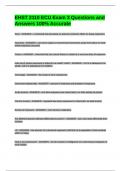Exam (elaborations)
EHST 2110 ECU Exam 3 Questions and Answers 100% Accurate
- Course
- Institution
EHST 2110 ECU Exam 3 Questions and Answers 100% AccurateEHST 2110 ECU Exam 3 Questions and Answers 100% AccurateEHST 2110 ECU Exam 3 Questions and Answers 100% AccurateEHST 2110 ECU Exam 3 Questions and Answers 100% Accurate Toxic - ANSWER - a chemical that provokes an adverse systemic effect on l...
[Show more]



